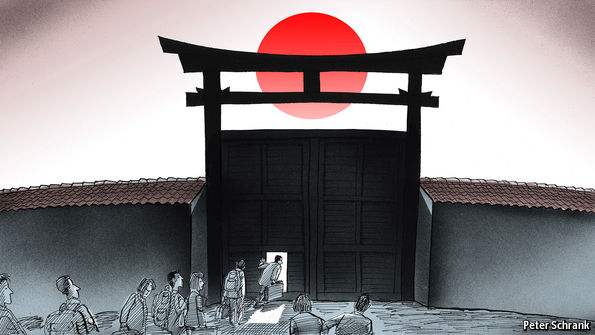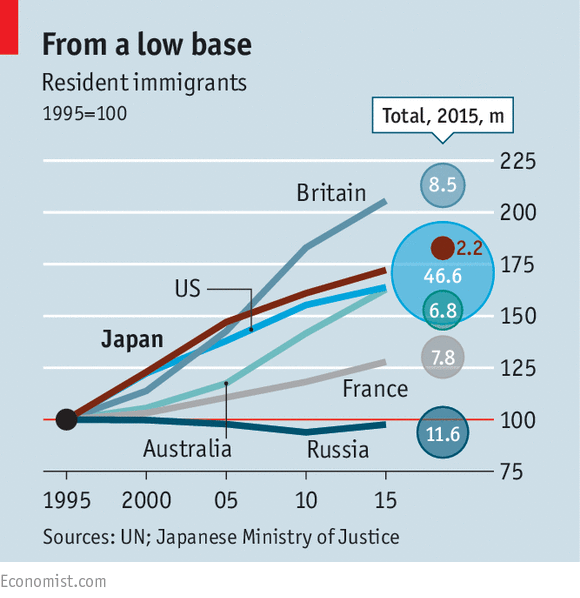
Immigration to Japan
A narrow passage
Begrudgingly, Japan is beginning to accept that it needs more immigrants
The Economist | 20 August 2016
IN THE
Shin-Okubo neighbourhood of Tokyo, smells of Korean food and snatches of the
language waft in the air. A supermarket selling kimchi sits next to an
Indian-run kebab shop—the latter complete with leaflets promoting Islam, the
religion of the Calcutta-born owner. A local estate agent advertises staff that
speak Chinese, Vietnamese and Thai alongside the floor plans for tiny Tokyo
apartments.
Shin-Okubo is a
rarity in Japan. The country has remained relatively closed to foreigners, who
make up only 2% of the population of 127m, compared with an average of 12% in
the OECD, a club of mostly rich countries. Yet Japan is especially short of
workers. Fully 83% of firms have trouble hiring, according to Manpower, a
recruiting firm, the highest of any country it surveys. And the squeeze is
likely to become much worse. The population is projected to drop to 87m by
2060, and the working-age population (15-64) from 78m to 44m, because of
ageing. The Keidanren, the Japan Business Federation, and prominent business
leaders such as Takeshi Niinami, the head of Suntory, a drinks company, have
long called for more immigration.

Shinzo Abe, Japan’s prime minister, says he
would prefer to raise the relatively low proportion of Japanese women who work,
and to keep all Japanese working later in life, before admitting droves of
foreigners. But his government has nonetheless taken a few small steps to boost
immigration. It has quietly eased Japan’s near-ban on visas for low-skilled
workers, with agreements to allow foreign maids to work in special economic
zones. It is now talking about relaxing requirements for Filipino carers. The authorities
have also made student and trainee visas easier to obtain, and turned a blind
eye to those who exploit them to recruit staff for jobs that involve very
little study or training at kombinis (the ubiquitous corner
stores, often staffed by Chinese) or in forestry, fishing, farming and
food-processing. It may extend trainee visas from three years to five. Mr Abe
has also boasted that he will reduce the time non-permanent residents need to
live in Japan before becoming eligible for permanent residence to the “shortest
in the world”—probably to less than three years (far from the shortest) from
the current five.
A few voices
advocate opening the door more widely. Hidenori Sakanaka, a former immigration
chief who now heads the Japan Immigration Policy Institute, a think-tank,
reckons Japan needs 10m migrants in the next 50 years. At the very least the
country needs a clear policy on bringing in menial foreign workers, rather than
ignoring the abuse of student and trainee visas, says Shigeru Ishiba, a
prominent lawmaker in the Liberal Democratic Party who is expected to challenge
Mr Abe for the party’s leadership in 2018. The government needs to lay out the
specifics of how many people it wants to attract and in what time-frame, he
says.
Public opinion
seems to be gradually shifting. The authors of a recent poll by WinGallup were
surprised that more Japanese favoured immigration than were against it—22% to
15%—although a whopping 63% said they were not sure. A warm embrace for lots of
foreigners is unlikely. Japan’s nationalists do not have the power of Europe’s
broad-based anti-immigrant movements. But the country prides itself on its
homogeneity, and although the media no longer reflexively blame foreigners for
all social ills, discrimination is still rife. Many landlords will not accept
foreign tenants, ostensibly, says Li Hong Kun, a Chinese estate agent in
Shin-Okubo, because they do not adhere to rules such as being quiet after 10pm
and sorting the rubbish properly (a complex task). Others suggest terrorist
attacks in Europe as a reason to keep Japan for the Japanese. Brazilians of
Japanese origin, who were encouraged to migrate to Japan in the 1980s, have
never really been accepted despite their Japanese ethnicity, notes Tatsuya
Mizuno, the author of a book on the community.
Even Mr Sakanaka and
Mr Ishiba think all migrants must learn the language and local customs, such as
showing respect for the imperial family. But the economic case for a bigger
influx is undeniable. For those, like Mr Abe, who speak of national revival,
there are few alternatives.


No comments:
Post a Comment